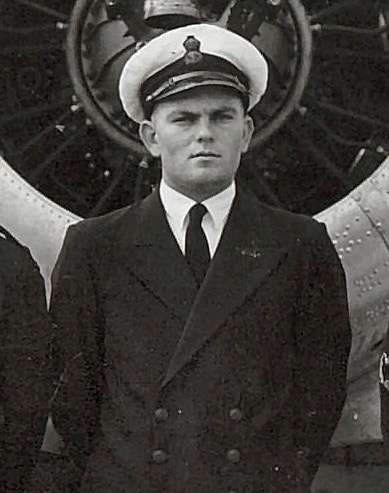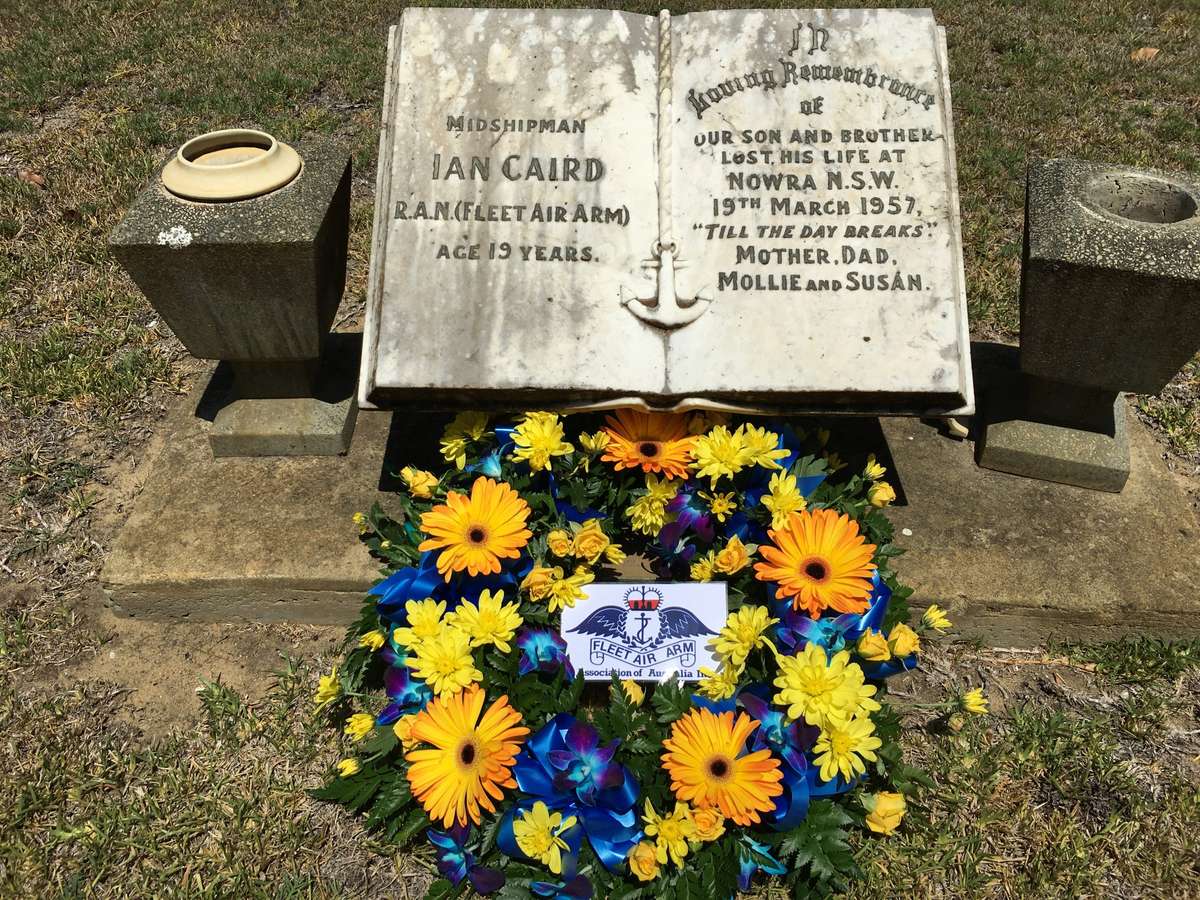Midshipman Ian Thomas Caird RAN
 Ian Thomas Caird was born on 30 October 1937, at Kalgoorlie, WA. He was the only son to Frank and Megan Caird, and brother to siblings Mollie and Susan. On 30 March 1955 he enlisted at Perth in the Royal Australian Navy as a Recruit Naval Airman (Aircrew) for a six-year term [commencing 30 October 1955]; at the time his occupation was listed as student.
Ian Thomas Caird was born on 30 October 1937, at Kalgoorlie, WA. He was the only son to Frank and Megan Caird, and brother to siblings Mollie and Susan. On 30 March 1955 he enlisted at Perth in the Royal Australian Navy as a Recruit Naval Airman (Aircrew) for a six-year term [commencing 30 October 1955]; at the time his occupation was listed as student.
On 31 March 1955, Caird was drafted to HMAS Cerberus (FND) the RAN training depot south of Melbourne. Upon arrival he began his initial recruit training and joined the Air Training Course to gauge suitability for aircrew training, which he passed. As a result he was then rated Probational Naval Airman (Aircrew) on 20 June 1955.
Having completed his primary training at Cerberus, Caird was drafted to RAAF Point Cook, (near Melbourne) on 08 July 1955, where he was enrolled in a Basic Flying Training Course. This involved studying flight theory, navigation and learning the basics of flying on a Link Trainer then progressing to practical flying with the aid of a tutor in a DH Tiger Moth. On 26 October 1955 he was rated PNA (P), continuing his aircrew training and building-up hours in the Tiger Moth.
On 16 April 1956, Caird passed his Basic Flight Training Course, finishing with his graduation from RAAF Point Cook on 10 May 1956. He was drafted to HMAS Lonsdale, at Port Melbourne for a short period, then on 15 May 1956 he returned to HMAS Cerberus for special RAN administrative training, prior to being promoted Midshipman on 06 June 1956.
On 09 June 1956 Caird was transferred to HMAS Albatross, the RAN Fleet Air Arm base at Nowra, NSW. Apparently, at this point a change in his aircrew career took place, as he began a Higher Ability Selection Test (HAST) and thereafter began an Observers Training Course. As an Observer Caird would be a crew member specialising in anti-submarine work, an important role which required special skills sets. The RAN Fleet Air Arm had a focus on anti-submarine warfare (ASW) at that time, with a growing demand for skilled Observers following the arrival of the new AS1 Fairey Gannet aircraft.
Because there is no record of the Squadrons Caird was assigned to at Albatross, it is reasonable to assume that after completing his Observers course, Caird joined 851 Squadron; as it was the chief anti-submarine training squadron at Nowra. Here he would have begun the practical OFS side of his Observer training, operating in rear cockpit of the AS6 Fairey Firefly. Much of this work involved navigation, radar operations, and detecting submarine acoustics with the aid of sonar-buoys. Caird’s job as an Observer was intense and lengthy work-up exercises were required.
The words and photograph below that recount the circumstances of WD869’s loss are provided with the kind permission of Jose Cordoba, from ADF Serials. More information about the accident can be found at the relevant page of ADF Serials’ website here.
Sub-Lieutenant Warren John Browne RAN
 Warren John Browne was born on 05 September 1935, at Goulburn, NSW. Details of his early life are not available, but prior to joining the Navy his occupation is listed as salesman. Browne enlisted in the Royal Australian Navy in Sydney on 05 September 1953 for six years as a Recruit Naval Airman (Aircrew), and was drafted to HMAS Cerberus (FND) south of Melbourne, arriving on 26 September 1953. Here he commenced his initial recruit training and participated in an Air Training Course to assess his suitability for further aircrew training.
Warren John Browne was born on 05 September 1935, at Goulburn, NSW. Details of his early life are not available, but prior to joining the Navy his occupation is listed as salesman. Browne enlisted in the Royal Australian Navy in Sydney on 05 September 1953 for six years as a Recruit Naval Airman (Aircrew), and was drafted to HMAS Cerberus (FND) south of Melbourne, arriving on 26 September 1953. Here he commenced his initial recruit training and participated in an Air Training Course to assess his suitability for further aircrew training.
By 26 November 1953 Browne had successfully completed his initial training at HMAS Cerberus. On the 27th he was promoted to Provisional Naval Airman (Aircrew) and drafted to RAAF Archerfield, at Brisbane, arriving on 30 November 1953, where he began a Basic Flying Training Course. This involved air navigation and flight theory. He then started his practical flying training in a Link Trainer, graduating (initially with an instructor) to fly a DH Tiger Moth. After building-up enough flying hours and demonstrating competence he would have then gone solo.
Having acquired a level of skill flying Tiger Moths at Archerfield, Browne was transferred to RAAF Uranquinty (near Wagga Wagga) on 03 July 1954. Here he began more advanced training flying in Tiger Moths, before moving to the more powerful single engine CAC Wirraway trainer for cross country exercises and weapons training. These exercises at Uranquinty were intensive, aimed at bringing trainees up to a high standard. Upon conclusion having passed all tests he graduated at RAAF Point Cook, where he received his ‘wings’.
Having completed his RAAF training, on 07 April 1955 Browne was promoted Acting Sub-Lieutenant (P), on a seven-year Short Service Commission, then drafted to HMAS Cerberus (FND) for an Officers Divisional Course from 18 to 29 April 1955. On 14 July 1955 he was drafted to the aircraft carrier HMAS Sydney for sea training, then to the RAN Naval Air Station HMAS Albatross, at Nowra NSW, where he was appointed to 724 Squadron, on 22 August 1955 for a Wirraway refresher course. Then on 12 January 1956 Browne transferred to 851 Squadron to begin an Operational Flying School 2 course which continued for several months.
On 15 May 1956 he was confirmed in the rank of Sub-Lieutenant (P) in 851 Squadron flying AS6 Fairey Fireflies. This continued until 07 January 1957 when he began a training course on the new AS1 Fairey Gannet aircraft, concentrating on operation of the turbo-prop Double Mamba engine system, and from 14 January he joined 724 Squadron for a Fairey Gannet conversion course.
On completion of the Fairey Gannet course Browne re-joined 851 Squadron on 11 February 1957, where he resumed flying Fairey Fireflies.
“On the night of 19 March 1957 the two young officers, now serving on 851 Squadron, left Albatross on a navigation exercise in Firefly WD869.
At 21:28, on the return leg of their journey, they crashed near the top of the mountains surrounding the valley of Foxground. Several Foxground residents witnessed the crash and they all said they had seen the aircraft flying very low before it impacted, exploding on impact. One of these residents immediately contacted Police Sergeant L. Daley from Berry who took his Jeep and six other Foxground residents up as far as it was possible to drive.

A Veary light was seen to rise shortly after the crash and there was a faint hope that someone may have survived. It was later determined that the cartridge had been ignited by the intense heat from the burning fuselage.
After leaving the Jeep, Sgt Daley and his team battled their way up the mountain in the extremely thick bush for an hour and a half, trying to reach anyone that might have survived.
When they finally reached the still burning wreckage they realized that it was too late to render any assistance to the unfortunate crew. Some twenty minutes later, the Navy rescue team arrived, having climbed the hills from Broughton Village. It was a weary and solemn group that gathered together as a Naval Officer said a prayer for the souls of his two young comrades.
The accident investigation concluded that the crew had mistaken the lighthouse at Kiama for that at Point Perpendicular on Beecroft Head. The aircraft was actually displaced some 20 miles north of their correct route, but they had descended below lowest safe altitude in the belief that they were on track back to Albatross.”
x
Final Resting Places
The remains of Sub Lieutenant Browne lie quietly in the Eastern Row of Nowra Cemetery, in the company of other officers who lost their lives in flying accidents in the local area.
Above. The remains of Midshipman Caird lie in the Karrakatta Cemetery in Perth. His grave was ‘rediscovered’ in 2019 and visited shortly thereafter to lay a wreath in his memory. He is interred with his father who died on 23 June 2000.
Ian Caird is buried next to Sub Lieutenant Leon Mauritz, who lost his life in a Gannet accident some two years later.
Right: The President of WA Division, Mr Greg Kelson, visiting the graves of Caird and Mauritz in early 2020 to pay his respects. This area of the cemetery is earmarked for conversion to a ‘lawn cemetery’ at some time in the future, but the graves will remain undisturbed and with appropriate recognition.
Compiled by Kim Dunstan using the following references:
National Archives of Australia
ADF Serials.
Mr Jose Cordoba
Advice from the President of WA Division of the FAAAA.
If anybody can provide photographs of Midshipman Caird, please contact the webmaster using the ‘Contact Us’ form below.




